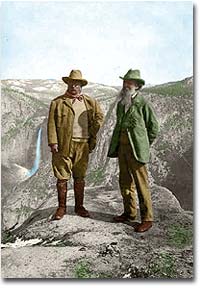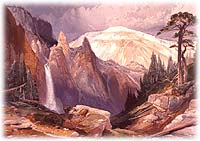43d. Preserving the Wilderness

As America grew, Americans were destroying its natural resources. Farmers were depleting the nutrients of the overworked soil. Miners removed layer after layer of valuable topsoil, leading to catastrophic erosion. Everywhere forests were shrinking and wildlife was becoming more scarce.
The Sierra Club
The growth of cities brought a new interest in preserving the old lands for future generations. Dedicated to saving the wilderness, the Sierra Club formed in 1892. John Muir, the president of the Sierra Club, worked valiantly to stop the sale of public lands to private developers. At first, most of his efforts fell on deaf ears. Then Theodore Roosevelt inhabited the Oval Office, and his voice was finally heard.
Roosevelt Protects Public Lands
Roosevelt was an avid outdoorsman. He hunted, hiked, and camped whenever possible. He believed that living in nature was good for the body and soul. Although he proved willing to compromise with Republican conservatives on many issues, he was dedicated to protecting the nation's public lands.
The first measure he backed was the Newlands Reclamation Act of 1902. This law encouraged developers and homesteaders to inhabit lands that were useless without massive irrigation works. The lands were sold at a cheap price if the buyer assumed the cost of irrigation and lived on the land for at least five years. The government then used the revenue to irrigate additional lands. Over a million barren acres were rejuvenated under this program.

Yellowstone's Tower Falls and Sulphur Mountain, one of the earliest tracts of preserved wilderness in America.
John Muir and Teddy Roosevelt were more than political acquaintances. In 1903, Roosevelt took a vacation by camping with Muir in Yosemite National Park. The two agreed that making efficient use of public lands was not enough. Certain wilderness areas should simply be left undeveloped.
Under an 1891 law that empowered the President to declare national forests and withdraw public lands from development, Roosevelt began to preserve wilderness areas. By the time he left office 150,000,000 acres had been deemed national forests, forever safe from the ax and saw. This amounted to three times the total protected lands since the law was enacted.
In 1907, Congress passed a law blocking the President from protecting additional territory in six western states. In typical Roosevelt fashion, he signed the bill into law — but not before protecting 16 million additional acres in those six states.
Conservation Fever
Conservation fever spread among urban intellectuals as a result. By 1916, there were sixteen national parks with over 300,000 annual visitors. The Boy Scouts and Girl Scouts formed to give urban youths a greater appreciation of nature. Memberships in conservation and wildlife societies soared.
Teddy Roosevelt distinguished himself as the greatest Presidential advocate of the environment since Thomas Jefferson. Much damage had been done, but America's beautiful, abundant resources were given a new lease on life.






